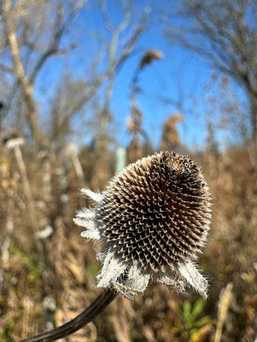As we embrace the beautiful fall season, ClearWater Conservancy is making sure our native gardens continue to support local wildlife through the colder months.
Here’s how we’re gardening with nature in mind:
Leave Seed Heads Intact: Even if flowers or grasses are dry or look “dead,” the seed heads are an important food source for birds during the winter months. Think of every little seed head as a winter dinner for our feathered friends!
Grasses: Tall grasses aren’t just beautiful—they’re a winter food source for birds, too! The thick stems also provide shelter for insects that will overwinter in the garden.
Leave Stems for Solitary Bees: Any fallen plant stems should be left at least 6 inches tall. This provides perfect nesting spots for solitary bees—an important part of our ecosystem!
Leave Fallen Leaves: Fallen leaves are a cozy refuge for insects that burrow in for the winter, helping them survive the cold. These leaves can also be added to garden beds to help nurture soil health come spring.
Of course, exceptions apply: we remove diseased plants, or anything that creates safety hazards. Next year, when the temperatures rise above 50°F for a week in late May, we’ll gather together to clean up flower stems and trim the tall grasses, making sure our garden stays healthy and beautiful year-round.
By leaving these winter resources in place, we’re not just growing plants—we’re also providing food and habitat for the birds, bees, and insects that help our environment thrive.
Come visit our native garden and see how simple fall practices can make a big difference for local wildlife. It’s a great example of how we can provide winter food and habitat for the birds and bees!
Read about our native garden here: https://www.clearwaterconservancy.org/garden
Learn more about why to leave the leaves at: https://www.xerces.org/blog/leave-the-leaves









































Comments